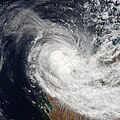File:Tropical Cyclone Hubert 2006.jpg
Appearance

Size of this preview: 600 × 600 pixels. Other resolutions: 240 × 240 pixels | 480 × 480 pixels | 768 × 768 pixels | 1,024 × 1,024 pixels | 2,048 × 2,048 pixels | 5,600 × 5,600 pixels.
Original file (5,600 × 5,600 pixels, file size: 3.6 MB, MIME type: image/jpeg)
File history
Click on a date/time to view the file as it appeared at that time.
| Date/Time | Thumbnail | Dimensions | User | Comment | |
|---|---|---|---|---|---|
| current | 03:00, 28 August 2006 |  | 5,600 × 5,600 (3.6 MB) | Good kitty | == Summary == {{Information |Description=Tropical Cyclone Hubert formed off the northwestern coast of Australia on April 5, 2006. Cyclones form in this area from December through April each year. In April, the start of the Asian Monsoon season gradually s |
File usage
The following page uses this file:
Global file usage
The following other wikis use this file:
- Usage on pt.wikipedia.org
- Usage on zh.wikipedia.org


